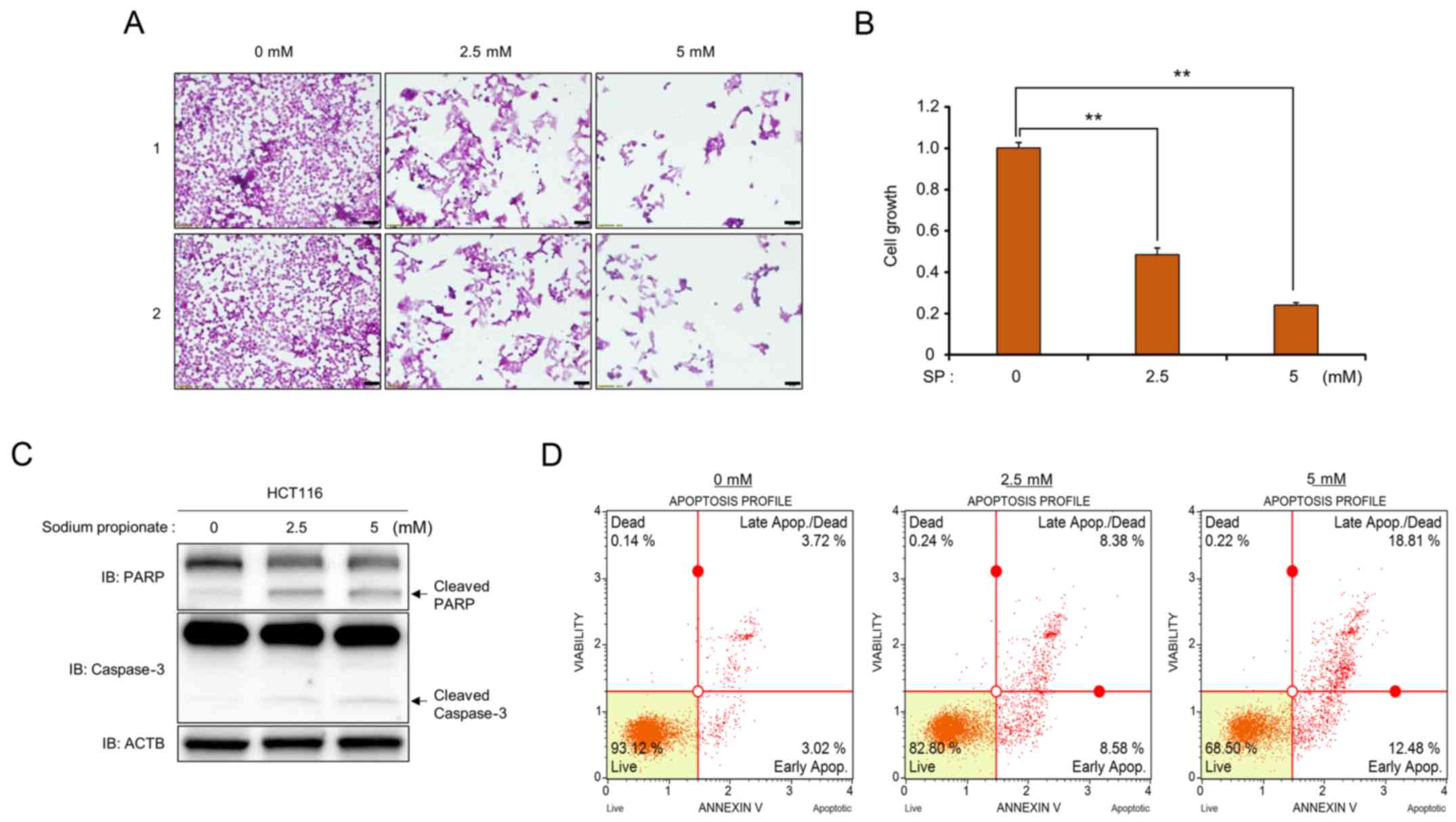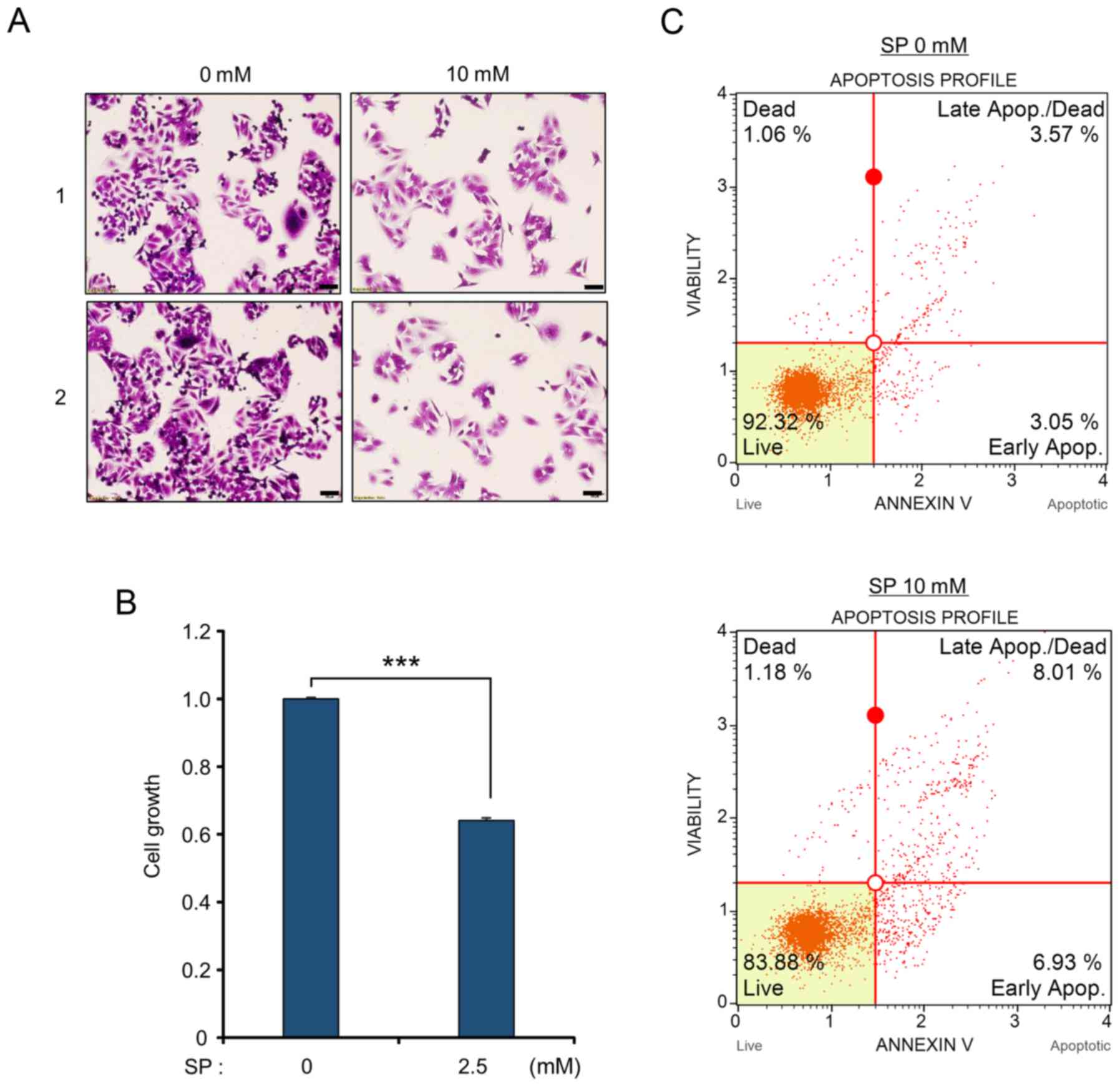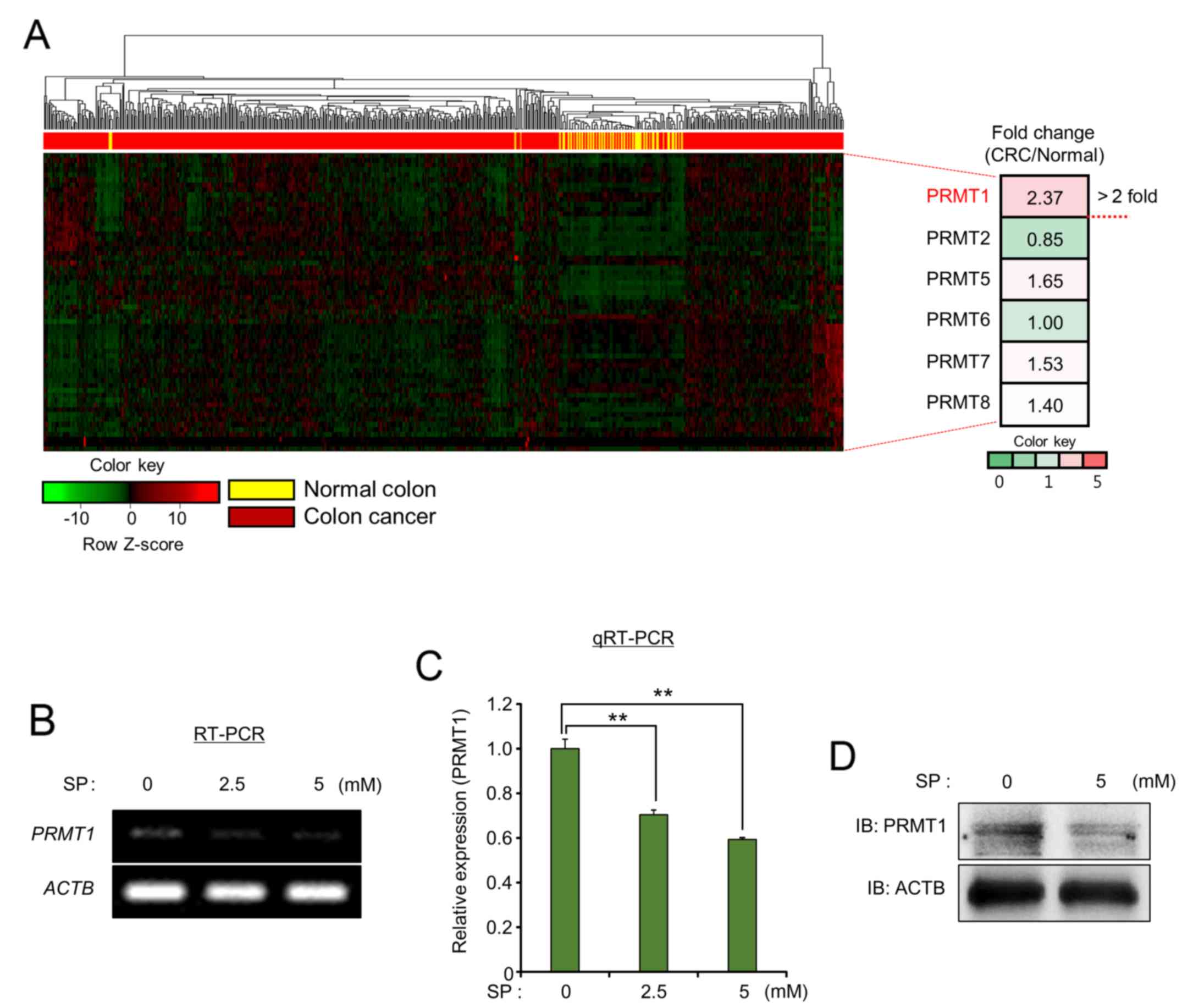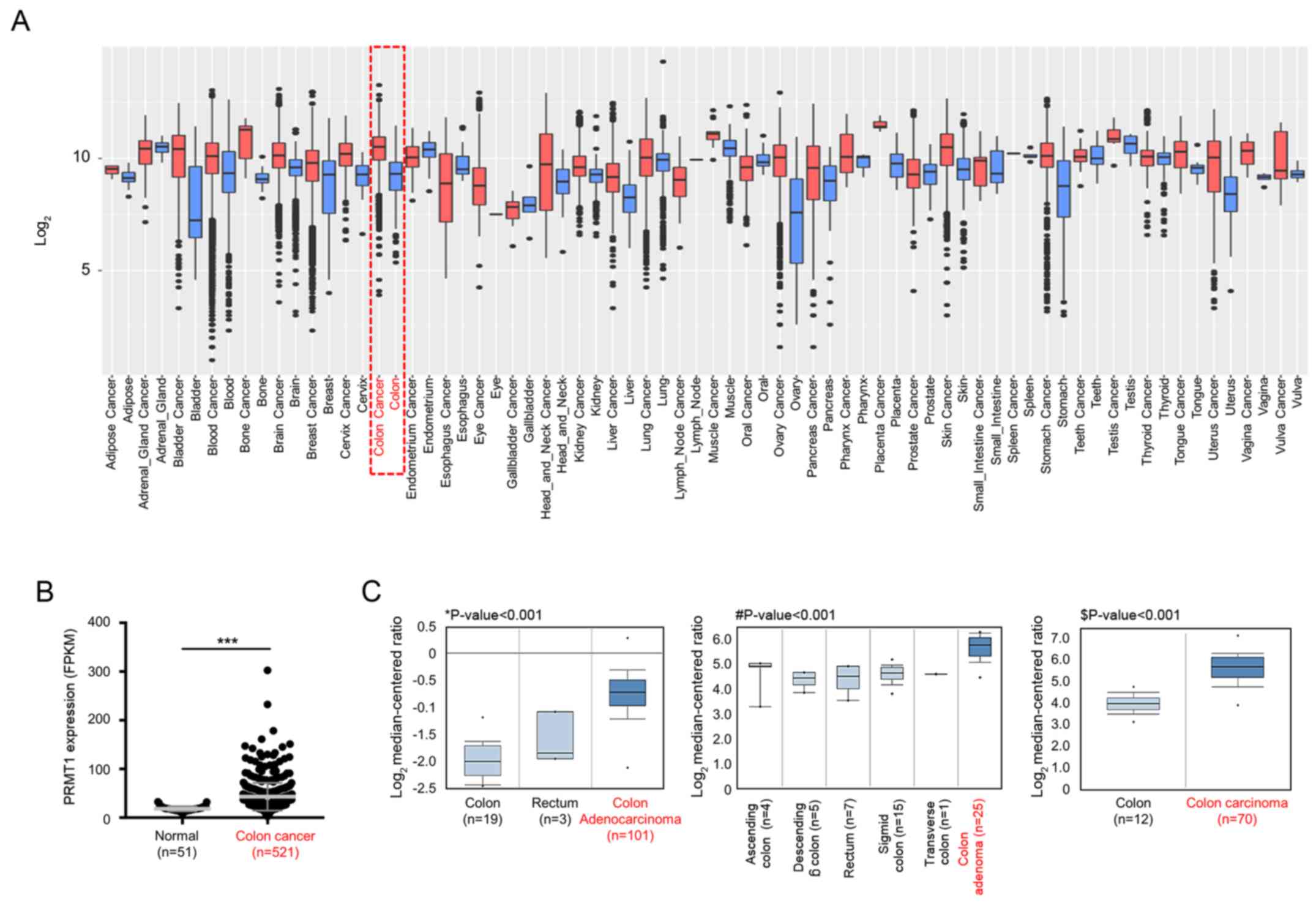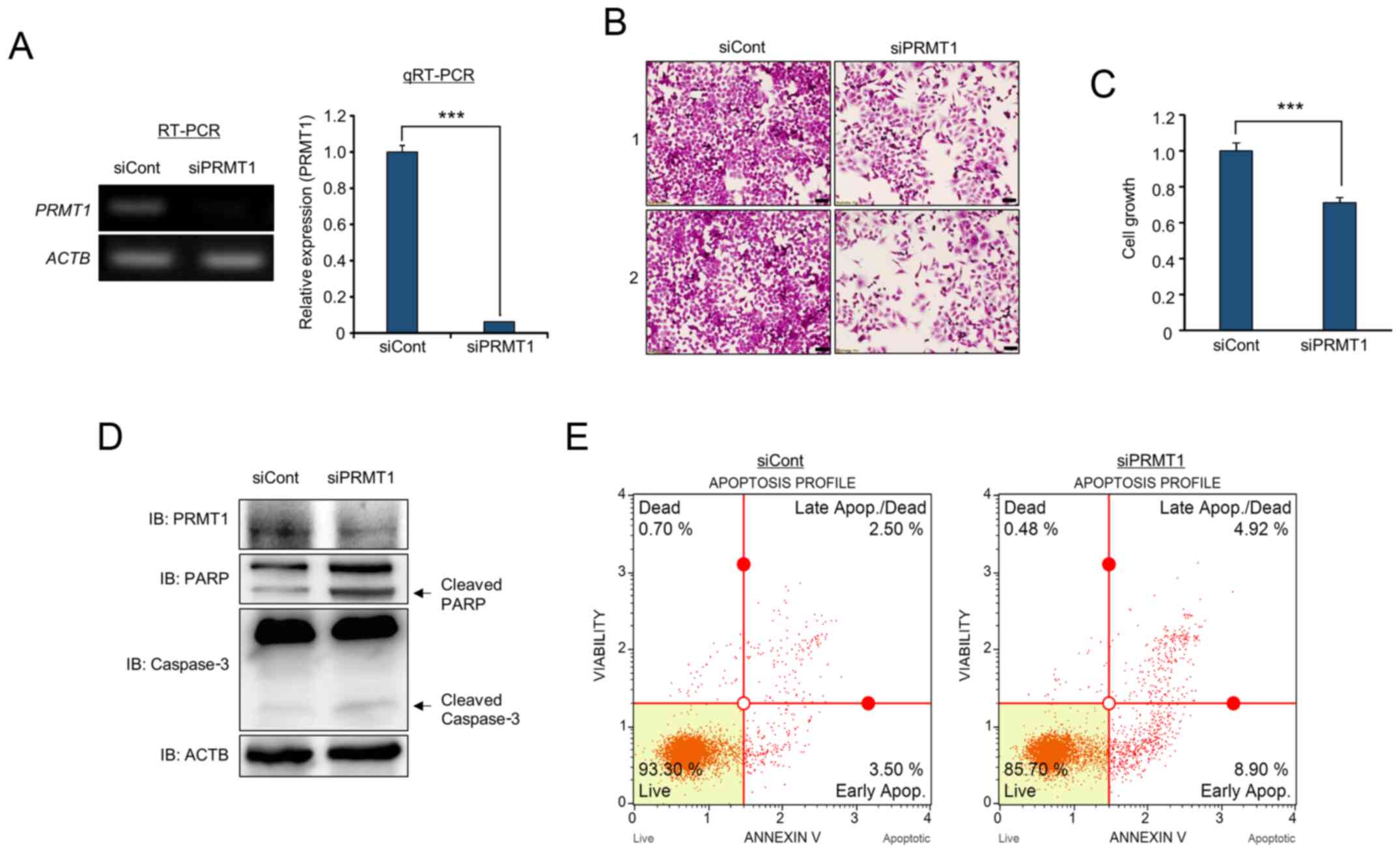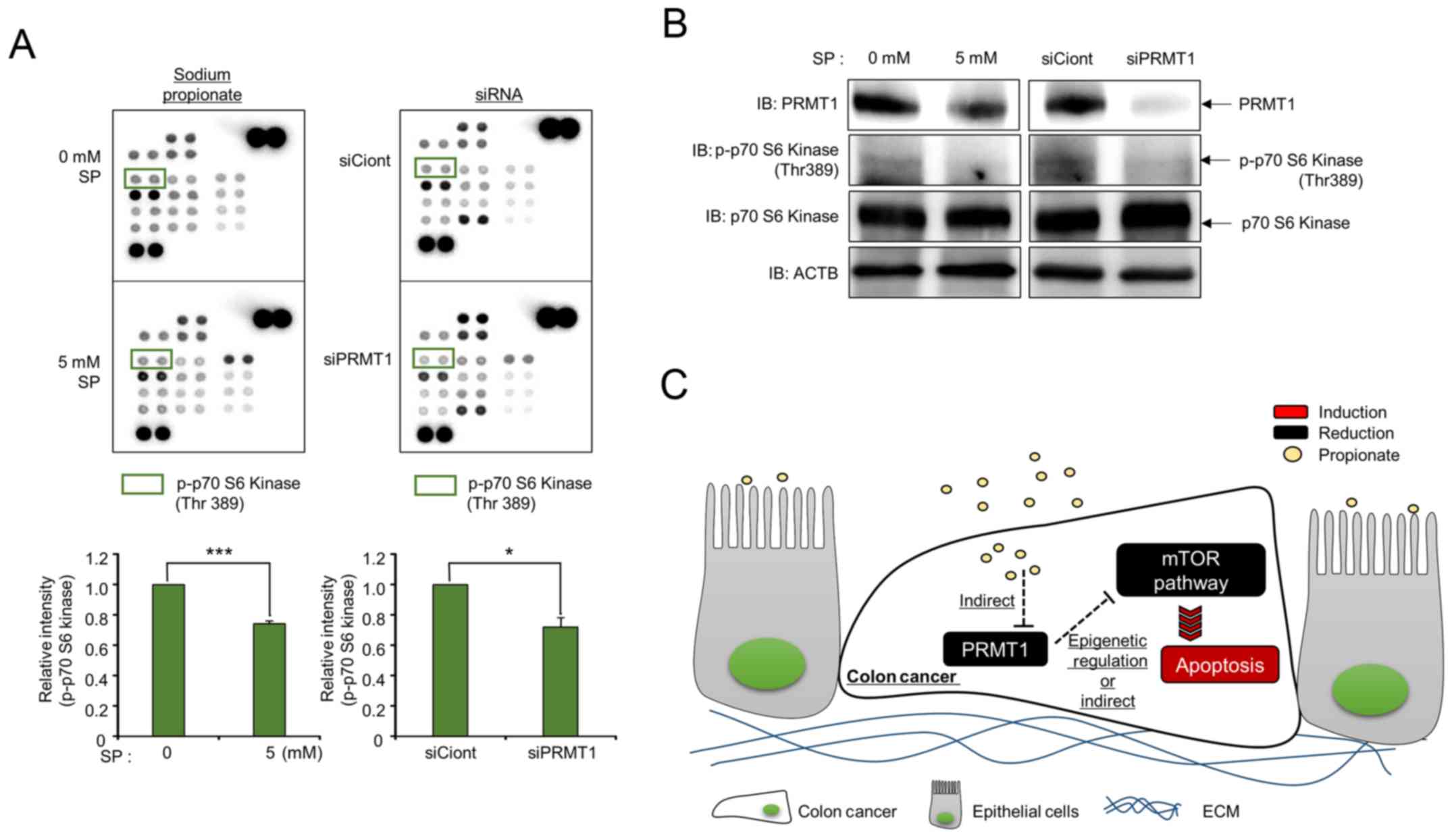Introduction
Colorectal cancer (CRC; colon and rectal cancer) is
the most common cancer worldwide. To overcome the challenges of CRC
treatment, recent studies of microbiota and metabolites derived
from the microbiome in the colon, have investigated alternative
methods for colon cancer prevention and treatment (1). Among these metabolites, short-chain
fatty acids (SCFAs; butyrate, acetate and propionate) are produced
from dietary fiber in the colon via bacterial fermentation to
maintain host health (2). Moreover,
in a disease context, SCFAs are related to colonic inflammation,
insulin resistance and high-fat-diet-induced obesity (3). The signaling components activated by
SCFAs have been divided into two main pathways: a histone
deacetylase (HDAC) inhibitor pathway and a G-protein coupled
receptor (GPCR) activation pathway (2). In colon cancer, treatment with SCFAs
was revealed to induce hyperacetylation and suppress colon cancer
proliferation and metastasis (4–7).
Specifically, butyrate induced apoptosis in HCT116 cells by
regulating p38 MAPK. Additionally, in an in vivo study, SCFA
mixtures suppressed azoxymethane/dextran sodium sulfate
(AOM/DSS)-induced tumors by inhibiting COX-2 expression (7–10). In
addition, propionate treatment was revealed to reduce free fatty
acid receptor 2 (FFAR2; also known as GPR43) expression in leukemic
cell lines and to reduce leukemic cell proliferation (11). However, despite studies on the roles
of SCFAs in the colon, their molecular mechanisms and target
development require further investigation. Moreover, since SCFA
studies have focused mainly on butyrate treatment, the relationship
between propionate and colon cancer was examined in this study.
SCFA treatment in colon cancer has been revealed to
induce hyper-acetylation by inhibiting HDAC activity, suggesting
that SCFAs can act as an HDAC inhibitor. Although major studies of
the anticancer effects of SCFAs (mainly butyrate) have focused on
inhibiting HDAC activity, the molecular mechanism of propionate in
colon cancer remains unclear. Epigenetic modifiers, such as histone
methyltransferase, acetylase and DNA methyltransferase, have become
important target genes for developing anticancer drugs for colon
cancer (12,13). Among these genes, protein arginine
methyltransferase 1 (PRMT1) is a histone arginine methyltransferase
that mainly mono- and dimethylates histone H4 arginine 3, which is
an activation site for gene expression (14,15).
In colon cancer, PRMT1 was revealed to be involved in epidermal
growth factor (EGF) receptor methylation during resistance to
cetuximab treatment, and methylation of methyl-DNA binding domain 2
(MBD2) by PRMT1 inhibited binding to methyl-CG DNA in colon cancer
(16,17). Moreover, PRMT1 overexpression was
revealed to be clearly associated with poor prognosis in colon
cancer cohorts. Although the relationship between colon cancer and
PRMT1 has been studied, regulation of PRMT1 expression in colon
cancer is unclear.
Therefore, in this study, the HCT116 cell line was
treated with sodium propionate (SP) and cellular apoptosis was
observed upon downregulation of PRMT1 expression. This is the first
study, to the best of our knowledge, revealing that downregulation
of PRMT1 expression by propionate, induced apoptosis by inhibiting
p70 S6 kinase phosphorylation. Thus, PRMT1 inhibitors and
propionate treatment are expected to reveal synergistic anticancer
effects which may be used in the treatment of CRC patients.
Materials and methods
Cell culture and reagents
The human colon cancer cell lines HCT116 and SW480
were purchased from the Korean Cell Line Bank (Seoul, South Korea)
and cultured in RPMI-1640 medium supplemented with 10% fetal bovine
serum (FBS) and 1% penicillin/streptomycin in a humidified
atmosphere with 5% CO2 at 37°C. Sodium propionate
(product no. P5436) was purchased from Sigma-Aldrich; Merck KGaA
(Darmstadt, Germany).
CRC patients in TCGA data
The mRNA expression (RNA-Seq) data of 572
colon-related samples (51 normal samples and 521 tumor samples) was
obtained from TCGA data portal (http://cancergenome.nih.gov). The RNA-Seq
quantification data (HTSeq-FPKM) was downloaded and the mean value
for the expression levels of each gene across samples was
calculated. These mean values represented the expression each gene
in normal and tumor samples.
Cell viability assay
Cell Counting Kit-8 (CCK-8; Dojindo Laboratories,
Rockville, MD, USA) was used to conduct cell viability assays.
Cells were seeded in 6-well plates starting at 4×105
cells/well and incubated for 24 h. After sodium propionate
treatment and siRNA transfection for 2 days, CCK-8 solution and
RPMI-1640 medium with 10% FBS mixture were added into each well and
incubated with 5% CO2 at 37°C for 5 min or 10 min. The
absorbance was assessed using a microplate reader at 450 nm. For
crystal violet staining, the cells were fixed with methanol for 5
min and stained with 0.1% crystal violet after sodium propionate
treatment and siRNA infection for 48 h.
Human phospho-kinase array
Human phospho-kinase array was performed using
Proteome Profiler Human Phospho-Kinase Array kit (cat. no. ARY003B)
purchased from R&D Systems, Inc. (Minneapolis, MN, USA). HCT116
cells, treated with sodium propionate and PRMT1 siRNA, were lysed
in lysis buffer. Cell lysates were centrifuged at 14,000 × g for 5
min at 4°C and diluted to 400 µg per array set. Cell lysates were
incubated with membranes overnight at 4°C on a rocking platform
shaker. Then, the membranes were incubated with detection antibody
cocktail for 2 h and Streptavidin-HRP for another 30 min at room
temperature. The signal was detected by incubating the membranes
with Chemi Reagent Mix and exposing to film.
FACS analysis
After treatment with SP or knockdown of PRMT1 for 2
days, the cells were collected and incubated with the MUSE Annexin
V and Dead Cell Assay kit (cat. no. MCH100105; Merck KGaA) for 20
min at room temperature. After incubation, ~5×104 cells
were analyzed using a Muse Cell analyzer (Merck KGaA) (18). The FACS result was analyzed using
Muse 1.5 Analysis (Merck KGaA).
siRNA transfection
siRNA duplexes against PRMT1 (siPRMT1;
5′-GAGUUCACACGCUGCCACATT-3′, 5′-UGUGGCAGCGUGUGAACUCTT-3′) were
purchased from ST Pharm Co., Ltd. (Seoul, South Korea). Negative
control siRNA (siCont; 5′-AUGAACGUGAAUUGCUCAATT-3′, 5′-UUG
AGCAAUUCACGUUCACTT-3′) was used as a control (19). The siRNAs (100 nM) were transfected
into cancer cell lines using RNAiMax (Invitrogen; Thermo Fisher
Scientific, Inc., Waltham, MA, USA) for 48 h.
Semi-quantitative reverse
transcription PCR and quantitative real-time PCR
Total RNA was isolated from the indicated cell lines
using a Qiagen RNeasy Mini kit (Qiagen Inc., Valencia, CA, USA)
according to the manufacturers instructions. RNA aliquots of 1 µg
were then reverse-transcribed using the iScript™ cDNA synthesis kit
(Bio-Rad Laboratories, Inc., Hercules, CA, USA), according to the
standard protocols provided by the manufacturer. For
semi-quantitative RT-PCR, cDNA was used as a template for PCR using
AccuPower® HotStart PCR PreMix (Bioneer, Daejeon, South
Korea). For quantitative RT-PCR, PCR reactions (PRMT1: annealing
temperature 55°C, 30 cycles; ACTB: annealing temperature 58°C, 28
cycles) were performed using the SimpliAmp Thermal Cycler (Applied
Biosystems; Thermo Fisher Scientific, Inc.) following the
manufacturers instructions. Quantitative real-time PCR was
performed on cDNA samples using Brilliant III Ultra-Fast
SYBR® Green QPCR Master Mix and the signal was detected
using AriaMx Real-Time PCR System (both from Agilent Technologies,
Inc., Santa Clara, CA, USA). The fluorescence threshold value was
calculated using Agilent Aria 1.6 software (Agilent Technologies,
Inc.) (20,21). The PCR primers were as follows:
PRMT1 forward, 5′-GGGCTACTGCCTCTTCTACGAGTC-3′ and reverse,
5′-GTCTTTGTACTGCCGGTCCTCGTAG-3′; and ACTB forward,
5′-ACTCTTCCAGCCTTCCTTCC-3′ and reverse,
5′-CAATGCCAGGGTACATGGTG-3′.
Western blot analysis
The cells were washed once with phosphate-buffered
saline (PBS) and then lysed in cold lysis buffer (50 mM Tris-HCl,
pH 7.4, 150 mM NaCl, 1% Triton X-100, 0.1% SDS, 1 mM EDTA, 1 mM
Na3VO4, 1 mM NaF and 1X protease inhibitor cocktail).
Cell lysates were centrifuged at 14,000 × g for 15 min at 4°C and
then boiled in 5X sample buffer following protein determination
(BSA, cat. no. 23208; Thermo Fisher Scientific, Inc.). The protein
samples were subjected to western blot analysis. For western blot
analysis, nitrocellulose membranes (cat. no. 1620145; Bio-Rad
Laboratories) and blocking reagent (5% skim milk, 1 h at room
temperature), 4–20% precasting gel (cat. no. 456-1094; Bio-Rad
Laboratories) were used with the indicated antibodies at a 1:1,000
dilution ratio (22). The samples
were stained with the following antibodies: anti-PRMT1 (cat. no.
2449), PARP (cat. no. 9542), caspase-3 (cat. no. 9662), phospho-p70
S6 kinase (Thr389) (cat. no. 9234), p70 S6 kinase (cat. no. 9202)
all from Cell Signaling Technology (Danvers, MA, USA) and PRMT1
(cat. no. sc-166963) and ACTB (cat. no. sc-47778) from Santa Cruz
Biotechnology, Inc. (Santa Cruz, CA, USA). Secondary antibodies
(rabbit; cat. no. SC-2357, mouse; cat. no. SC-2031; Santa Cruz
Biotechnology) were incubated at room temperature for 1 h, and ECL
solution (cat. no. 170-5060; Bio-Rad Laboratories) was used for
visualization. Chemiluminescence imaging system (Mini HD9; UVitec,
Cambridge, UK) was used for imaging.
Statistical analysis
Results were expressed as the mean ± SD (error bars)
of three independent experiments. One-way analysis of variance
(ANOVA) with Bonferroni post hoc test was performed using Graphpad
Prism 5.0 (Graphpad Software, Inc., La Jolla, CA, USA). The cut-off
for significance was P<0.05.
Results
SP suppresses the proliferation of the
HCT116 and SW480 cell lines
First, to verify the anticancer activity of
propionate in colon cancer, a cell growth assay and CCK-8 analysis
were performed. Following treatment with SP, a significant SP
dose-dependent reduction of the number of cells and growth rates
was observed compared to those of the control (Figs. 1A and B and 2A and B). In addition, in western blot
analysis, cleaved PARP and cleaved caspase-3 were clearly increased
after SP treatment, implying that propionate suppressed cell
proliferation in CRC cell lines via the apoptosis pathway (Fig. 1C). Moreover, FACS analysis using
Annexin V staining after treatment with SP revealed that the
proportion of apoptotic cells (early and late apoptotic cells)
increased compared to that of the control group in a dose-dependent
manner in HCT116 and SW480 cell lines (Figs. 1D and 2C). Thus, treatment of CRC cell lines with
propionate revealed anticancer effects similar to those of butyrate
treatment.
Treatment with propionate reduces
PRMT1 expression in the HCT116 cell line
Recently, epigenetic modifiers related to DNA
methylation and histone modification have been strongly associated
with cell proliferation and metastasis in several types of cancer
(23). Therefore, in the present
study, the identification of the novel epigenetic modifiers
controlled by propionate treatment in colon cancer, was attempted.
To investigate the relationship between epigenetic modifiers and
propionate treatment in colon cancer, an in silico
epigenetic panel (61 histone methyltransferases/demethylases, 28
histone acetylases/deacetylases and 7 DNA
methyltransferases/demethylases) was established to select
epigenetic modifiers overexpressed in colon cancer (data not
shown). To examine the expression levels of epigenetic modifiers,
the RNA-seq results for colon cancer (n=521) and normal samples
(n=51) derived from the TCGA portal were evaluated, and PRMT1,
which is a histone arginine methyltransferase 1 (>2-fold
change), was selected from the PRMTs (Fig. 3A). Since the knockdown of PRMT1 was
revealed to suppress cell proliferation in hepatocellular carcinoma
(HCC), lung cancer and bladder cancer (15,24),
RT-PCR and qRT-PCR analysis after treatment with SP in the HCT116
cell line was performed to assess the relationship between
propionate treatment and PRMT1 expression. As observed in Fig. 3B and C, the expression level of
PRMT1 was decreased by SP treatment in a dose-dependent manner.
Concurrently, the reduction of PRMT1 expression by SP treatment
using western blot analysis was confirmed (Fig. 3D). Collectively, these data revealed
the negative regulation of PRMT1 expression by propionate treatment
in colon cancer, indicating that PRMT1 downregulation induced by SP
treatment may lead to anticancer effects via the induction of cell
apoptosis.
Overexpression of PRMT1 in colon
cancer
GENT2 analysis (http://gent2.appex.kr/gent2/) revealed that PRMT1 was
overexpressed in several types of cancer, including colon cancer
(Fig. 4A), and dot blot graph
revealed that the expression levels of PRMT1 were significantly
increased in colon cancer, with data derived from the TCGA portal
(Fig. 4B). Additionally, in
Oncomine data (https://www.oncomine.org), the expression level of
PRMT1 in colon cancer samples was higher than that in normal colon
and rectum samples (Fig. 4C). Thus,
in colon cancer, PRMT1 was overexpressed, and the functions of
PRMT1 in colon cancer may be involved in colon cancer
proliferation. These results indicated that overexpressed PRMT1 may
become a useful molecular target for propionate treatment.
Knockdown of PRMT1 suppresses cell
proliferation via the apoptosis pathway
To determine whether overexpressed PRMT1 is related
to colon cancer proliferation, a PRMT1-specific siRNA was designed
and PRMT1 knockdown analysis was performed. In RT-PCR and qRT-PCR
analysis, PRMT1 expression was significantly decreased by treatment
with siPRMT1 compared to that in cells treated with siCont
(Fig. 5A). In cell growth analysis,
cell staining with crystal violet revealed that the number of
stained cells was reduced by PRMT1 knockdown (Fig. 5B). In addition, the proliferation of
HCT116 cells was clearly suppressed after the knockdown of PRMT1
using CCK-8 analysis (Fig. 5C).
Additionally, as revealed in Fig.
1D, PRMT1 knockdown induced cleaved PARP and caspase-3 compared
to the levels in cells treated with siCont; moreover, in FACS
analysis, the proportion of apoptosis was increased in PRMT1
knockdown samples (Fig. 5D and E).
Thus, it was demonstrated that PRMT1 expression was associated with
colon cancer proliferation, and cell apoptosis induced by
propionate treatment was linked to the PRMT1-related apoptosis
pathway.
p70 S6 kinase phosphorylation status
is regulated by SP treatment and PRMT1 knockdown
To assess the pathway for propionate/PRMT1-induced
apoptosis, a phospho-array was purchased from R&D Systems.
Fig. 6A revealed that the intensity
of positive spots after treatment with 0 mM propionate was similar
to that of the positive spots after treatment with 5 mM propionate;
however, the p70 S6 kinase (Thr389) phosphorylation status was
reduced by 5 mM SP treatment compared to that of the control. Tang
et al reported that the phosphorylation of mTOR, 4E-BP1 and
p70 S6 kinase was reduced depending on the concentration of
propionate and the incubation time, and the mTOR pathway was
involved in the suppression of colon cancer proliferation and the
stimulation of cell apoptosis (9,25,26).
Notably, the results of the phospho-array using cell lysates from
cells subjected to PRMT1 knockdown also demonstrated that the
phosphorylation of p70 S6 kinase was reduced compared to that of
cells subjected to SP treatment (Fig.
6A). To confirm the phospho-array results, western blot
analysis was carried out using a phospho-antibody. After treatment
of HCT116 cells with SP, the downregulation of PRMT1 expression was
clearly detected, and the phosphorylation of p70 S6 kinase was
reduced after both PRMT1 knockdown and 5 mM SP treatment compared
to that of cells treated with siCont and 0 mM SP (Fig. 6B). Collectively, these results
indicated that treatment with SP induced cell apoptosis via the
inhibition of the mTOR signaling pathway by PRMT1 downregulation in
colon cancer (Fig. 6C). Therefore,
this novel PRMT1-related mechanism induced by propionate treatment
in colon cancer may help to increase our understanding of the use
of propionate treatment for colon cancer patients.
Discussion
Epigenetic modifiers [histone methyltransferase
(HMT)/demethylase (HDM]), histone acetyltransferase
(HAT)/deacetylase (HDAC) and DNA methyltransferase/demethylase]
have been investigated as therapeutic targets for developing
anticancer drugs in several cancers. In colon cancer,
overexpression of epigenetic modifiers plays an important role in
proliferation and metastasis. For example, EZH2, SMYD3, EHMT2 and
LSD1 have been linked with colon cancer proliferation. In addition,
p300 and HDAC are important factors in colon cancer (27–30).
Thus, studies on reducing epigenetic modifier expression are
required to treat colon cancer.
In the present study, it was demonstrated that PRMT1
is overexpressed in several cancers, including colon cancer, using
GENT2, the TCGA portal and Oncomine data (Fig. 4). Generally, benign and malignant
tumors are the main tumor types. In malignant tumors, carcinoma
(carcinoma, squamous cell carcinoma and adenocarcinoma), sarcoma
and undifferentiated carcinoma are divided. In colon cancer
progression, several steps occur (Polyp >> precancer
[adenoma] >> Stage I–IV). Thus, using Oncomine data, we
focused on the high PRMT1 expression in several tumor types
including malignant tumors and adenoma compared with the normal
colon and rectum. In Fig. 4C, PRMT1
was overexpressed in colon adenoma, carcinoma and adenocarcinoma
according to Oncomine data. Thus, it was indicated that PRMT1 was
overexpressed in early colon cancer stages, and its overexpression
may help to acquire malignant characteristics for colon cancer
progression. In addition, it was clearly demonstrated that
propionate treatment downregulated PRMT1 in the HCT116 cell line
(Fig. 3). Subsequently, PRMT1
downregulation induced apoptosis by inhibiting phospho-p70 S6
kinase as revealed by siPRMT1 treatment (Figs. 5 and 6), however, to confirm the anticancer
effect of SP, cell growth assays with crystal violet were performed
after SP treatment (0 and 5 mM) in normal enterocytes and the
HCT116 cell line. Notably, the effect of SP treatment could not be
detected in normal enterocytes (data not shown). Therefore, it is
suggested that SP may play a role as an anticancer agent for colon
cancer treatment.
Recently, our group reported that PRMT1 could serve
as a prognostic and therapeutic marker in hepatocellular carcinoma
(HCC), and PRMT1 overexpression downregulated CDKN1A to promote HCC
proliferation (15). Additionally,
Mathioudaki et al reported that high PRMT1 expression was
associated with poor survival rates in patients with colon cancer
(31). Therefore, PRMT1 should be
recognized as a useful therapeutic marker for CRC treatment, and
developing novel methods for downregulating PRMT1 expression or
activity is important for CRC therapy. AMI-1 is a pan-PRMT
inhibitor, and treatment with this agent suppressed cell
proliferation by reducing arginine methylation. However, problems
have been reported regarding the specificity and adverse effects of
PRMT inhibitors (32). Thus,
downregulation of PRMT1 by propionate treatment should be
recognized as a safe procedure for CRC treatment since propionate
is a bacterial fermentative product in the colonic epithelium and a
safe compound authorized in the EU for food use. Therefore,
developing PRMT1 inhibitors and establishing guidelines for
co-treatment with propionate and PRMT1 are required to increase the
curative value of this approach in CRC treatment.
As revealed in Fig.
3, although propionate treatment decreased PRMT1 expression,
the definite mechanisms that link propionate and PRMT1 regulation
remain unknown. Similar to butyrate, propionate was also revealed
to inhibit HDAC (5). First, it was
hypothesized that the reduction in HDAC activity by propionate
would decrease PRMT1 expression. However, as hyperacetylation by
propionate is associated with reconstructing the euchromatin
structure from heterochromatin to induce gene expression, PRMT1
downregulation by propionate may not be involved in the
hyperacetylation mechanism. However, upregulation of unknown
regulators by propionate-induced hyperacetylation may affect the
suppression of PRMT1 expression. Thus, the relationship between
PRMT1 and propionate should be investigated, and the status of
H4R3me2 after SP treatment should be validated in further
studies.
SCFA treatment induced apoptosis in colon cancer via
mitochondrial defects and mTOR pathway inhibition (25,26,33).
Additionally, the cAMP/PKA/CREB pathway is controlled by SCFAs for
dysregulating inflammatory suppressors in the colonic epithelium
(34). In the present study, to
ascertain the common signaling pathway for cellular apoptosis used
by propionate and PRMT1 knockdown, phospho-array analysis was
performed after treatment with propionate and siPRMT1 and a
reduction in p70 S6 kinase phosphorylation after separate
treatments with propionate and siPRMT1 was observed (Fig. 6A). This is the first study, to the
best of our knowledge, which revealed PRMT1-related mTOR signaling
pathway effects in colon cancer. Liao et al demonstrated
that overexpressed PRMT1 methylated the EGF receptor to increase
EGFR signaling activation. Subsequently, the ERK and AKT pathways
were activated for survival during cetuximab treatment (16). Thus, it is suggested that: i) the
AKT pathway, which is regulated by PRMT1, may affect the mTOR
pathway; or ii) the epigenetic mechanism induced by PRMT1 may
regulate the mTOR pathway. Therefore, this study was the first to
report PRMT1 downregulation by propionate treatment in the HCT116
cell line. Suppressed cell growth via mTOR signaling pathway
inhibition was also observed. Thus, this mode-of-action (MOA) study
of propionate treatment in colon cancer may provide a basis for new
guidelines, such as a dietary therapy, for CRC patients.
Acknowledgements
Not applicable.
Funding
The present study was supported by the National
Research Foundation of Korea (NRF) grant funded by the Korean
government (MSIT) (NRF-2018M3A9H3023077) and the KRIBB Research
Initiative Program. The funders had no role in the study design,
data collection or analysis, decision to publish, or preparation of
the manuscript.
Availability of data and materials
The datasets used during the present study are
available from the corresponding author upon reasonable
request.
Authors contributions
DSK and HSC were involved in the conception and
design of the study. TYR, TSH and KK were involved in the
development of the methodology. DSK, MYS and JKM were involved in
the analysis and interpretation of the data (e.g., statistical
analysis, biostatistics and computational analysis). KK, TYR, JK,
DSK, MYS, JKM and HSC were involved in the writing, reviewing
and/or revision of the manuscript. JK and JKM were responsible for
administrative, technical or material support. DSK and HSC
supervised the study. All authors read and approved the manuscript
and agree to be accountable for all aspects of the research in
ensuring that the accuracy or integrity of any part of the work are
appropriately investigated and resolved.
Ethics approval and consent to
participate
Not applicable.
Patient consent for publication
Not applicable.
Competing interests
The authors declare that they have no competing
interests.
Glossary
Abbreviations
Abbreviations:
|
CRC
|
colorectal cancer
|
|
SP
|
sodium propionate
|
|
SCFA
|
short-chain fatty acid
|
|
TCGA
|
The Cancer Genome Atlas
|
|
MBD2
|
methyl-DNA binding domain 2
|
|
FACS
|
fluorescence-activated cell
sorting
|
|
FBS
|
fetal bovine serum
|
|
siCont
|
siRNA control
|
|
HDAC
|
histone deacetylase
|
|
CCK-8
|
Cell Counting Kit-8
|
|
HCC
|
hepatocellular carcinoma
|
|
EU
|
European union
|
|
MOA
|
mode of action
|
References
|
1
|
Rea D, Coppola G, Palma G, Barbieri A,
Luciano A, Del Prete P, Rossetti S, Berretta M, Facchini G, Perdonà
S, et al: Microbiota effects on cancer: From risks to therapies.
Oncotarget. 9:17915–17927. 2018. View Article : Google Scholar : PubMed/NCBI
|
|
2
|
Tan J, McKenzie C, Potamitis M, Thorburn
AN, Mackay CR and Macia L: The role of short-chain fatty acids in
health and disease. Adv Immunol. 121:91–119. 2014. View Article : Google Scholar : PubMed/NCBI
|
|
3
|
McNabney SM and Henagan TM: Short chain
fatty acids in the colon and peripheral tissues: A focus on
butyrate, colon cancer, obesity and insulin resistance. Nutrients.
9:13482017.doi: 10.3390/nu9121348. View Article : Google Scholar :
|
|
4
|
Davie JR: Inhibition of histone
deacetylase activity by butyrate. J Nutr. 133 Suppl:2485S–2493S.
2003. View Article : Google Scholar : PubMed/NCBI
|
|
5
|
Hinnebusch BF, Meng S, Wu JT, Archer SY
and Hodin RA: The effects of short-chain fatty acids on human colon
cancer cell phenotype are associated with histone hyperacetylation.
J Nutr. 132:1012–1017. 2002. View Article : Google Scholar : PubMed/NCBI
|
|
6
|
Ooi CC, Good NM, Williams DB, Lewanowitsch
T, Cosgrove LJ, Lockett TJ and Head RJ: Structure-activity
relationship of butyrate analogues on apoptosis, proliferation and
histone deacetylase activity in HCT-116 human colorectal cancer
cells. Clin Exp Pharmacol Physiol. 37:905–911. 2010. View Article : Google Scholar : PubMed/NCBI
|
|
7
|
Tian Y, Xu Q, Sun L, Ye Y and Ji G:
Short-chain fatty acids administration is protective in
colitis-associated colorectal cancer development. J Nutr Biochem.
57:103–109. 2018. View Article : Google Scholar : PubMed/NCBI
|
|
8
|
Fung KY, Brierley GV, Henderson S,
Hoffmann P, McColl SR, Lockett T, Head R and Cosgrove L:
Butyrate-induced apoptosis in HCT116 colorectal cancer cells
includes induction of a cell stress response. J Proteome Res.
10:1860–1869. 2011. View Article : Google Scholar : PubMed/NCBI
|
|
9
|
Tang Y, Chen Y, Jiang H and Nie D: The
role of short-chain fatty acids in orchestrating two types of
programmed cell death in colon cancer. Autophagy. 7:235–237. 2011.
View Article : Google Scholar : PubMed/NCBI
|
|
10
|
Yu DC, Bury JP, Tiernan J, Waby JS, Staton
CA and Corfe BM: Short-chain fatty acid level and field
cancerization show opposing associations with enteroendocrine cell
number and neuropilin expression in patients with colorectal
adenoma. Mol Cancer. 10:272011. View Article : Google Scholar : PubMed/NCBI
|
|
11
|
Bindels LB, Porporato PE, Ducastel S,
Sboarina M, Neyrinck AM, Dewulf EM, Feron O, Lestavel S, Cani PD,
Staels B, et al: Ffar2 expression regulates leukaemic cell growth
in vivo. Br J Cancer. 117:1336–1340. 2017. View Article : Google Scholar : PubMed/NCBI
|
|
12
|
Kondo Y and Issa JP: Epigenetic changes in
colorectal cancer. Cancer Metastasis Rev. 23:29–39. 2004.
View Article : Google Scholar : PubMed/NCBI
|
|
13
|
Okugawa Y, Grady WM and Goel A: Epigenetic
alterations in colorectal cancer: Emerging biomarkers.
Gastroenterology. 149:1204–1225.e1212. 2015. View Article : Google Scholar : PubMed/NCBI
|
|
14
|
An W, Kim J and Roeder RG: Ordered
cooperative functions of PRMT1, p300, and CARM1 in transcriptional
activation by p53. Cell. 117:735–748. 2004. View Article : Google Scholar : PubMed/NCBI
|
|
15
|
Ryu JW, Kim SK, Son MY, Jeon SJ, Oh JH,
Lim JH, Cho S, Jung CR, Hamamoto R, Kim DS, et al: Novel prognostic
marker PRMT1 regulates cell growth via downregulation of CDKN1A in
HCC. Oncotarget. 8:115444–115455. 2017. View Article : Google Scholar : PubMed/NCBI
|
|
16
|
Liao HW, Hsu JM, Xia W, Wang HL, Wang YN,
Chang WC, Arold ST, Chou CK, Tsou PH, Yamaguchi H, et al:
PRMT1-mediated methylation of the EGF receptor regulates signaling
and cetuximab response. J Clin Invest. 125:4529–4543. 2015.
View Article : Google Scholar : PubMed/NCBI
|
|
17
|
Tan CP and Nakielny S: Control of the DNA
methylation system component MBD2 by protein arginine methylation.
Mol Cell Biol. 26:7224–7235. 2006. View Article : Google Scholar : PubMed/NCBI
|
|
18
|
Kim SK, Kim K, Ryu JW, Ryu TY, Lim JH, Oh
JH, Min JK, Jung CR, Hamamoto R, Son MY, et al: The novel
prognostic marker, EHMT2, is involved in cell proliferation via
HSPD1 regulation in breast cancer. Int J Oncol. 54:65–76.
2019.PubMed/NCBI
|
|
19
|
Kim K, Son MY, Jung CR, Kim DS and Cho HS:
EHMT2 is a metastasis regulator in breast cancer. Biochem Biophys
Res Commun. 496:758–762. 2018. View Article : Google Scholar : PubMed/NCBI
|
|
20
|
Kim DS, Ryu JW, Son MY, Oh JH, Chung KS,
Lee S, Lee JJ, Ahn JH, Min JS, Ahn J, et al: A liver-specific gene
expression panel predicts the differentiation status of in vitro
hepatocyte models. Hepatology. 66:1662–1674. 2017. View Article : Google Scholar : PubMed/NCBI
|
|
21
|
Son MY, Jung CR, Kim DS and Cho HS:
Comparative in silico profiling of epigenetic modifiers in human
tissues. Mol Biol Rep. 45:309–314. 2018. View Article : Google Scholar : PubMed/NCBI
|
|
22
|
Jung KB, Lee H, Son YS, Lee MO, Kim YD, Oh
SJ, Kwon O, Cho S, Cho HS, Kim DS, et al: Interleukin-2 induces the
in vitro maturation of human pluripotent stem cell-derived
intestinal organoids. Nat Commun. 9:30392018. View Article : Google Scholar : PubMed/NCBI
|
|
23
|
Nebbioso A, Tambaro FP, Dell'Aversana C
and Altucci L: Cancer epigenetics: Moving forward. PLoS Genet.
14:e10073622018. View Article : Google Scholar : PubMed/NCBI
|
|
24
|
Yoshimatsu M, Toyokawa G, Hayami S, Unoki
M, Tsunoda T, Field HI, Kelly JD, Neal DE, Maehara Y, Ponder BA, et
al: Dysregulation of PRMT1 and PRMT6, type I arginine
methyltransferases, is involved in various types of human cancers.
Int J Cancer. 128:562–573. 2011. View Article : Google Scholar : PubMed/NCBI
|
|
25
|
Kapral M, Wawszczyk J, Jesse K,
Paul-Samojedny M, Kusmierz D and Weglarz L: Inositol hexaphosphate
inhibits proliferation and induces apoptosis of colon cancer cells
by suppressing the AKT/mTOR signaling pathway. Molecules.
22:16572017.doi: 10.3390/molecules22101657. View Article : Google Scholar :
|
|
26
|
Tang Y, Chen Y, Jiang H and Nie D:
Short-chain fatty acids induced autophagy serves as an adaptive
strategy for retarding mitochondria-mediated apoptotic cell death.
Cell Death Differ. 18:602–618. 2011. View Article : Google Scholar : PubMed/NCBI
|
|
27
|
Chen J, Ding J, Wang Z, Zhu J, Wang X and
Du J: Identification of downstream metastasis-associated target
genes regulated by LSD1 in colon cancer cells. Oncotarget.
8:19609–19630. 2017.PubMed/NCBI
|
|
28
|
Luo CW, Wang JY, Hung WC, Peng G, Tsai YL,
Chang TM, Chai CY, Lin CH and Pan MR: G9a governs colon cancer stem
cell phenotype and chemoradioresistance through PP2A-RPA
axis-mediated DNA damage response. Radiother Oncol. 124:395–402.
2017. View Article : Google Scholar : PubMed/NCBI
|
|
29
|
Sarris ME, Moulos P, Haroniti A,
Giakountis A and Talianidis I: Smyd3 is a transcriptional
potentiator of multiple cancer-promoting genes and required for
liver and colon cancer development. Cancer Cell. 29:354–366. 2016.
View Article : Google Scholar : PubMed/NCBI
|
|
30
|
Yamamoto I, Nosho K, Kanno S, Igarashi H,
Kurihara H, Ishigami K, Ishiguro K, Mitsuhashi K, Maruyama R, Koide
H, et al: EZH2 expression is a prognostic biomarker in patients
with colorectal cancer treated with anti-EGFR therapeutics.
Oncotarget. 8:17810–17818. 2017. View Article : Google Scholar : PubMed/NCBI
|
|
31
|
Mathioudaki K, Papadokostopoulou A,
Scorilas A, Xynopoulos D, Agnanti N and Talieri M: The PRMT1 gene
expression pattern in colon cancer. Br J Cancer. 99:2094–2099.
2008. View Article : Google Scholar : PubMed/NCBI
|
|
32
|
Hu H, Qian K, Ho MC and Zheng YG: Small
molecule inhibitors of rotein arginine methyltransferases. Expert
Opin Investig Drugs. 25:335–358. 2016. View Article : Google Scholar : PubMed/NCBI
|
|
33
|
Park J, Kim M, Kang SG, Jannasch AH,
Cooper B, Patterson J and Kim CH: Short-chain fatty acids induce
both effector and regulatory T cells by suppression of histone
deacetylases and regulation of the mTOR-S6K pathway. Mucosal
Immunol. 8:80–93. 2015. View Article : Google Scholar : PubMed/NCBI
|
|
34
|
Pan P, Oshima K, Huang YW, Agle KA,
Drobyski WR, Chen X, Zhang J, Yearsley MM, Yu J and Wang LS: Loss
of FFAR2 promotes colon cancer by epigenetic dysregulation of
inflammation suppressors. Int J Cancer. 143:886–896. 2018.
View Article : Google Scholar : PubMed/NCBI
|















